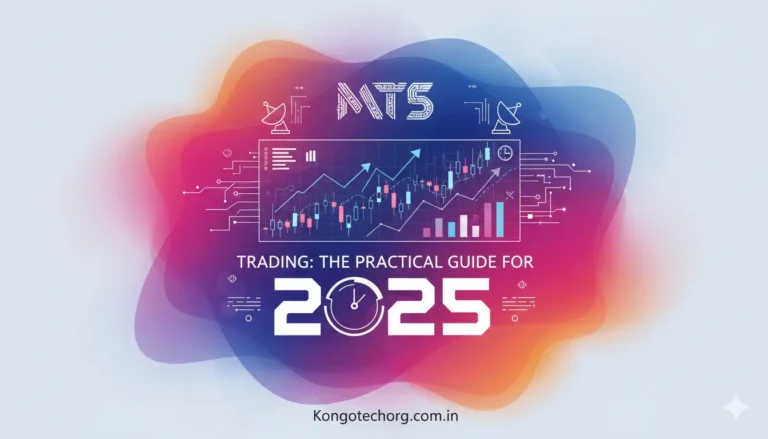If you’ve heard of MT5 trading but aren’t sure where to start, this guide walks you through setup, features, strategies, and risk control. MetaTrader 5 (MT5) is a popular multi-asset platform with faster backtesting, more order types, and expanded timeframes compared with MT4.
You’ll learn how to install MT5, connect a broker, add indicators and EAs, and run a clean backtest before risking real money. We’ll cover practical strategies trend-following, breakouts, and algorithmic approaches plus position sizing and trade journaling so you can improve systematically. By the end, you’ll be ready to place your first trade on MT5 with a plan, not a guess.
What Is MT5 Trading?
MT5 (MetaTrader 5) is a multi-asset platform where traders analyze charts, place orders, automate strategies with EAs (expert advisors), and backtest. Unlike MT4—which was built primarily for FX—MT5 natively supports stocks, indices, commodities, crypto (via CFDs), and futures depending on your broker’s offerings.
MT5 vs MT4: Key Differences
| Feature | MT5 | MT4 |
|---|---|---|
| Assets | Multi-asset (FX, stocks, indices, commodities, crypto via CFDs) | Primarily FX/CFDs |
| Timeframes | 21 (including M2, M3, M10, etc.) | 9 |
| Order Types | Market, Limit, Stop, Stop-Limit, trailing stop | Market, Limit, Stop, trailing stop |
| Depth of Market (DOM) | Yes (Level II) | Limited |
| Strategy Tester | Multi-threaded, multi-currency, real ticks | Single-threaded, less granular |
| Programming | MQL5 (OOP-friendly, faster) | MQL4 |
| Economic Calendar | Built-in | No (requires add-ons) |
| Community Market | Indicators/EAs/signals | Indicators/EAs/signals |
| Backward Compatibility | MT4 EAs don’t run on MT5 | — |
Bottom line: If you need richer timeframes, faster backtesting, and multi-asset access, MT5 wins. If you rely on a legacy MT4 EA, you’ll need an MQL5 version or conversion.
Asset Classes You Can Trade on MT5
- Forex (majors, minors, exotics)
- Indices (US30, SPX500, GER40, etc.)
- Commodities (gold, oil, silver)
- Stocks/ETFs (if broker supports exchange connectivity)
- Crypto CFDs (BTC, ETH, etc., availability varies by region)
Getting Started on MT5
Download & Installation (Windows/Mac/Web)
- Download MT5 from an official source or directly from your broker.
- Install and launch. Mac users can use native builds (where supported) or emulation layers provided by brokers.
- WebTrader: If you can’t install software, use MT5 Web to trade from any browser.
Opening a Demo vs Live Account
- Demo: Risk-free environment with virtual funds. Use it to learn the UI, test order types, and backtest/forward-test strategies.
- Live: Real money and market conditions. Start small and scale only after consistent demo results.
Connecting to a Broker & Data
- Click File → Open an Account → choose your broker’s server → enter credentials.
- Verify market watch symbols are visible, spreads/commissions are acceptable, and trading hours match your plan.
Core MT5 Features to Know
Timeframes, DOM, and Order Types
- Timeframes: MT5 offers 21. For scalping, use M1–M5; for swing, H1–H4/D1.
- Depth of Market (DOM): Shows liquidity at each price step—handy for gauging slippage risk and executing limit/stop-limit orders.
- Order Types:
- Market: Fill immediately at best available.
- Limit: Better price than current market; waits to be filled.
- Stop: Triggers a market order when price crosses a level.
- Stop-Limit: Triggers a limit order when the stop price is touched (more control in volatile conditions).
- Trailing Stop: Follows price to lock in gains.
Indicators & Custom Add-Ons
- Built-ins: MA, RSI, MACD, Bollinger Bands, ATR, etc.
- Custom indicators: Add via File → Open Data Folder → MQL5 → Indicators and restart MT5.
- Templates/Profiles: Save chart layouts and multi-chart workspaces.
Strategy Tester & Backtesting Basics
- Open Strategy Tester (Ctrl+R).
- Choose Expert Advisor or Indicator, symbol, timeframe, and date range.
- Use Every tick based on real ticks for accuracy.
- Review equity curve, drawdown, profit factor, win rate, expectancy, and trade distribution.
- Run parameter optimizations but avoid overfitting—validate on out-of-sample periods.
MT5 Trading Strategies (With Setup Tips)
Always test on demo first. Document rules, inputs, and risk settings so you can repeat results.
1) Trend-Following with Moving Averages + RSI
Idea: Trade in the direction of the dominant trend; use RSI to filter weak pullbacks.
- Indicators: 50-EMA, 200-EMA, RSI(14).
- Buy: 50-EMA > 200-EMA; price pulls back near 50-EMA; RSI avoids overbought blow-off (>70) at entry.
- Stop-loss: Below recent swing low or ATR(14) × 1.5.
- Take-profit: At 1.5–2× risk or trailing via parabolic SAR/chandelier.
- Notes: Works best on H1–H4 for FX/indices; avoid high-impact news windows.
2) Breakout Strategy with ATR Stops
Idea: Trade momentum bursts from a tight range.
- Indicators: ATR(14), Donchian Channels(20) or manual range boxes.
- Buy: Price closes above recent range high; ATR rising suggests expansion.
- Stop-loss: ATR(14) × 1.5–2.0 below the breakout level.
- Take-profit: Partial at 1R, trail remainder by ATR or 20-EMA.
- Notes: Backtest across sessions; some pairs break better in London/NY overlap.
3) EA / Algorithmic Trading on MQL5
Idea: Automate entries/exits to remove emotion and enforce rules.
- Approach:
- Define entry logic (e.g., MA cross + RSI filter).
- Encode risk (fixed fractional or volatility-adjusted).
- Implement time filters (avoid illiquid hours).
- Backtest → optimize lightly → validate on out-of-sample.
- Pros: Consistency, 24/5 operation.
- Cons: Curve-fit risk; requires monitoring VPS, slippage, latency.
Risk & Money Management (Non-Negotiable)
- Position sizing: Risk 0.5%–1% of equity per trade until you’re consistently profitable.
- Stops are mandatory: Place stops before entry and size the position to the stop distance.
- Max drawdown rule: Pause trading if equity draws down >10%; review logs and market regime.
- R-multiple mindset: Think in R (risk units). Aim for positive expectancy (e.g., win rate 45% with average win 2R).
- Journaling: Track setup, confluence, pre-mortem notes, exit rationale, and screenshot. Review weekly to tighten rules.
- News awareness: Spreads widen and slippage increases during high-impact releases—reduce size or stand aside.
MT5 Brokers & Account Types: What to Check
- Regulation & reputation: Prioritize brokers with credible oversight in your region.
- Costs: Compare spreads + commissions + swaps; test on your instruments/timeframes.
- Execution quality: Fill speed, slippage, partial fills, and server stability.
- Account types: Standard vs raw/ECN; minimum deposit; base currency.
- Instruments & hours: Ensure your plan’s symbols are supported with consistent liquidity.
- Funding & withdrawals: Fees, speed, and available methods.
- Tools: VPS, social/copy trading, API access if needed.
Troubleshooting & Pro Tips
- Charts not updating? Check you’re connected to the correct server and symbol is “Show All” in Market Watch.
- Order rejected? Volume min/max, market closed, or insufficient margin—verify specification panel for each symbol.
- EA not trading? Enable Algo Trading (toolbar), confirm you allowed live trading in EA properties, check Journal tab for errors.
- Performance lag? Reduce chart objects/indicators, limit history, or upgrade VPS specs if running EAs.
MT5 vs MT4 (At-a-Glance Table)
| Category | MT5 | MT4 |
|---|---|---|
| Best For | Multi-asset traders, strategy testers, algorithmic devs in 2025 | Traders tied to legacy MT4 EAs/indicators |
| Strength | More timeframes, order types, faster tester, DOM | Massive legacy community, simplicity |
| Limitation | MT4 EAs not compatible; learning curve | Slower tester; fewer timeframes; limited DOM |
| Verdict | Recommended for most new traders | Niche if you must run MT4-only tools |
Beginner Checklist: Start MT5 Trading in 7 Steps
- Install MT5 (desktop or web) and open a demo account.
- Connect to your broker server; confirm spreads, commissions, and trading hours on your instruments.
- Set up charts: pick your timeframes, add a clean template (candles + 1–2 indicators max).
- Pick one strategy from this guide (e.g., trend-following) and write rules (entry, stop, target, exit).
- Backtest your rules over at least 2–3 years and multiple market regimes; avoid over-optimizing.
- Forward-test on demo for 2–4 weeks, tracking every trade in a journal.
- Go live small (≤1% risk/trade), review weekly, and scale only after you show positive expectancy over 50–100 trades.
You might also like:
Top 10 Direct Selling Companies in India
What is 7off7roo? Complete Guide
FAQs
Is MT5 better than MT4 for beginners?
Generally yes—MT5 provides more order types, timeframes, and a stronger strategy tester. That said, MT4’s simplicity and giant legacy EA library can be attractive for specific use cases.
Can I use EAs from MT4 on MT5?
No. MT4 uses MQL4 and MT5 uses MQL5. You need an MT5-compatible EA or a rewrite.
How do I backtest a strategy in MT5?
Open Strategy Tester (Ctrl+R), select your EA/indicator, symbol, timeframe, dates, and model (“every tick based on real ticks”). Evaluate drawdown, PF, win rate, and stability across regimes.
Is MT5 free and safe to use?
The platform is free to download. Safety depends on your broker and the third-party tools you install—use reputable sources only.
What’s the best timeframe for MT5 trading?
There isn’t one. Scalpers favor M1–M5; swing traders use H1–H4/D1. Match timeframe to your strategy and testing data.
How do I copy trade on MT5?
Use the built-in Signals marketplace or broker-provided copy features. Vet providers’ long-term equity curves, max drawdown, and sample size.




